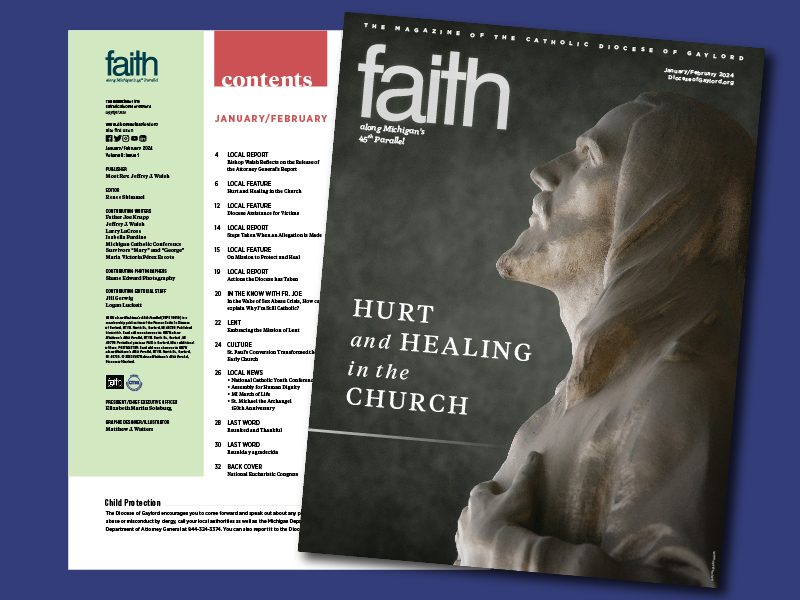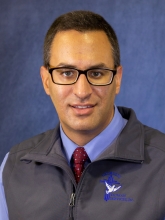Attorney General Report Jan. 8, 2024

On Jan. 8, 2024, the office of the Michigan Attorney General released its report concerning allegations of clergy sexual abuse within the Diocese of Gaylord.
Here are the key report findings.
To read the complete report, visit the Attorney General’s website.
Listening Sessions with Bishop Walsh
Bishop Jeffrey Walsh invites the faithful to Listening Sessions to address concerns and answer questions about the recently released Michigan Attorney General’s Report on clergy sexual abuse. These sessions will include discussion and prayer.
Join Bishop Walsh at any of the following Listening Sessions:
· Jan. 29, All Saints, Parish Hall, in Alpena (held)
· Feb. 4, 3 pm, Immaculate Conception, Parish Hall, Traverse City
· Feb. 5, 6 pm, St. Joseph, School Cafeteria, West Branch
For more information, contact the Diocesan Communications Office at 989-732-5147 or email communications@dioceseofgaylord.org
Bishop Walsh's Message to the Faithful
Press Conference
Watch Bishop Walsh's press conference that aired 1 pm, Jan. 8, 2024
Q&A
- When and why did the Attorney General's investigation begin?
According to the report: “On Sept. 21, 2018, the Michigan Department of Attorney General (AG), in partnership with the Michigan State Police (MSP), launched an investigation into clergy sexual abuse throughout the State of Michigan, focusing on the seven Dioceses of Michigan’s Catholic Church. One purpose of the investigation was to investigate whether criminal charges could be filed against those who allegedly engaged in potentially criminal conduct or those who failed to comply with a statutory obligation to report conduct involving minors. The other purpose of the investigation was to determine if the Archdiocese and the Dioceses were complying with their statutory obligation to report sexual abuse of minors.
“On Oct. 3, 2018, a search warrant was simultaneously executed on the Archdiocese and all six dioceses in order to seize any information and records each diocese had regarding reports of sexual abuse...It (the searches) lasted 8 hours and more than 220 boxes of documents were seized. In total, an estimated 1.5 million paper documents were seized.”
- Has the Diocese of Gaylord cooperated with the investigation?
Yes. Since the Michigan Department of Attorney General’s investigation began, the Diocese of Gaylord has turned over all requested documents and immediately reported any new allegations of sexual abuse or misconduct involving clergy to the Attorney General’s Office. The Attorney General’s report summary states: “All seven Dioceses have cooperated with the AG’s investigation.”
- How many priests and deacons are listed in the report for the Diocese of Gaylord?
The Attorney General’s report includes allegations against 26 priests and 2 deacons who serve or served in the Diocese of Gaylord. Of the 28 clergy, 18 were incardinated in the Diocese of Gaylord; 8 priests and 2 deacons were from various religious orders or other dioceses who ministered in the Diocese of Gaylord. Of the 28 clergy, 16 are known or presumed to be deceased.
- When did the alleged incidents of sexual abuse occur?
Approximately 85% of the alleged incidents of sexual abuse occurred prior to 2000.
- When did the alleged incidents of sexual abuse of a minor occur?
Nearly all the reported sexual abuse allegations involving minors occurred before 2000. The two instances that were reported since 2000 were inappropriate conduct cases by a priest who is no longer in ministry.
- Are the allegations in the report in the report either credible or substantiated?
Not necessarily. The Attorney General’s report states, “The allegations are summarized here, and their inclusion does not reflect a determination by the Department that the allegations are credible or otherwise substantiated nor indicative of a crime.”
- What is the difference between a credible allegation and a substantiated allegation?
A credible allegation is an allegation with a “semblance of truth,” meaning it appears to be or could possibly be true. There is a presumption of innocence until and unless an individual is proven guilty. In comparison, a substantiated allegation is an allegation that is supported by sufficient evidence establishing reasonable grounds to believe that the abuse occurred.
- How many priests from the Diocese of Gaylord have been convicted?
None. The report states: “To date, eleven cases have been brought by the Department of Attorney General for all seven dioceses. Nine have resolved with convictions. Of these eleven cases, none are related to priests ministering in the Diocese of Gaylord.”
- Why are there not more convictions?
According to the Attorney General’s report: “If the SOL [statute of limitations] has expired, Michigan law does not permit the AG or local prosecutors to pursue criminal charges. Prior to 2001, the SOL for criminal sexual conduct in the first degree (CSC 1) was six years from the date of offense, or the victim’s 18th birthday day. In 2001, the Legislature eliminated the SOL for first-degree criminal sexual conduct (CSC 1), making it possible to bring criminal charges at any time…. Where appropriate, criminal charges were brought. For the vast majority of cases in all six Dioceses and the Archdiocese, a criminal prosecution has simply not been possible either because the priest who engaged in the sexual abuse of minors was dead, the SOL had expired, the conduct did not violate Michigan law, or the person who was allegedly sexually abused by the priest did not wish to pursue criminal charges.”
- When were allegations of sexual abuse by clergy received by the diocese or law enforcement?
Below is a chart showing the decade of when the alleged abuse occurred compared to the decade the alleged abuse was reported. When comparing the timeframes, one can see that many individuals reported to the diocese or law enforcement years or decades after the incident.
It is not uncommon for victims/survivors of sexual abuse to report many years later due to the nature of sexual trauma. Often victims have been threatened by the abuser or feel they will not be believed. Some suppress or repress memories, which only surface later. Young children who are sexually abused may not understand what is happening or do not have the language to describe it.
However, when a survivor makes the courageous decision to report the abuse, regardless of their age or how much time has passed, it becomes the right time for them and an opportunity for justice and healing.
- What is the difference between inconclusive, unsubstantiated and non-credible allegation?
An inconclusive allegation has been investigated by competent authorities, but the evidence does not indicate whether or not the allegation is true. This may be the result of an investigation with either little or with conflicting information.
An unsubstantiated allegation has been investigated by competent authorities and the resulting evidence does not corroborate it. An unsubstantiated allegation may be the conclusion of an investigation in which the evidence does not appear to show it to be true.
A non-credible allegation is determined on basic information not to have a semblance of truth, meaning it appears implausible to have occurred. For example, an allegation may be determined to be non-credible if the individual was not serving or present at the time the abuse was alleged to have taken place.
Hurt and Healing in the Church
For additional information pertaining to the hurt and healing in the Church due to clergy sexual abuse. Click image to read.








